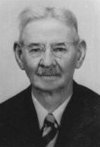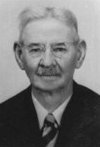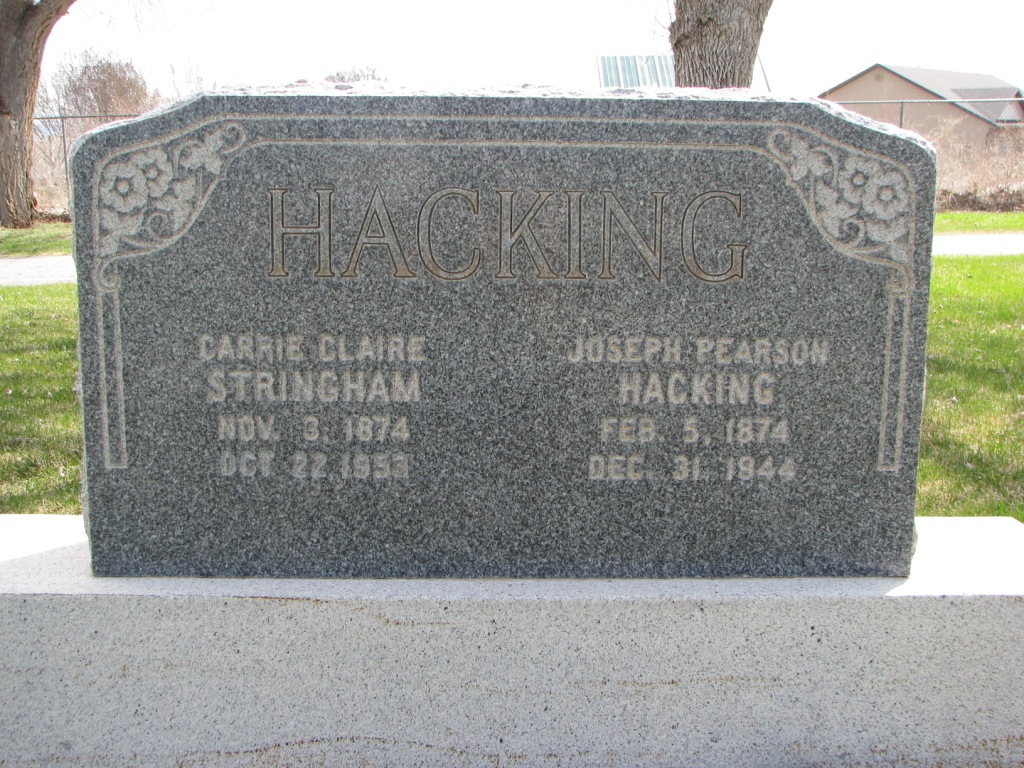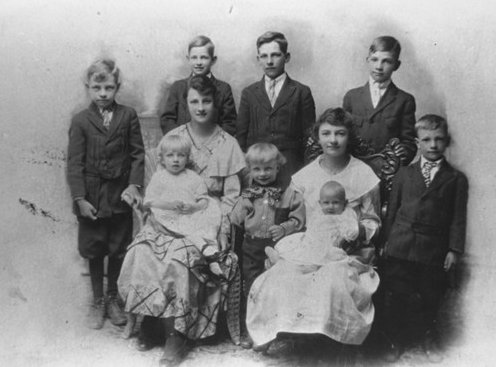------------------------
Funeral Held For Maeser Stockman. Joseph P. Hacking Dies Sunday From Heart Ailment.
Funeral services were conducted in Maeser Ward Chapel at 2 p.m.Wednesday for Joseph P. Hacking who died suddenly at his home Sunday morning of a heart attack. Verdin R. Johnson of the bishopric conducted.
A duet "In the Garden" was sung by Mrs. May Calder and Earl Calder. Invocation was offered by Patriarch Fred G. Bingham. Mrs. Lucille Calder, by request of the deceased sang, "The Children's Friend," accompanied by Mrs. Mary Manwaring.
B. O. Colton of Roosevelt, who served eight years in the Maeser bishopric with Mr. Hacking, was the first speaker. Bishop Lester Bingham was the next speaker. A violin solo was played by Mrs. Lorna M. Condon, "Perfect Day," accompanied by Mrs. Helen C. Larsen. President Archie Johnson was the third speaker followed by a solo, "Goin Home," by Mrs. Mae Jorgensen, accompanied by Mrs. Mable Stagg. Benediction was by John L. McConkie.
Interment was in the Maeser Cemetery where the grave was dedicated by Wallace Calder. Pallbearers were Fred G. Bingham, Wallace Calder, W. S. Henderson, H. S. Sowards. J. A. Cheney and Henry B. Millecam. Members of the High Priests group, of which Mr. Hacking was a member, lined the walk.
Joseph P. Hacking, 70, prominent Ashley sheep raiser and businessman was born February 5, 1874 at Cedar Fort, Utah County, a son of John Sampson and Jane Clark Hacking. He came to Ashley Valley in 1895 bringing with him one of the first sheep herds to enter the section. He continued in the sheep business the rest of his life and reputedly had one of the best outfits in eastern Utah.
He was among the founders of the Vernal Milling & Light Company and Raven Oil Company.
Active for many years in LDS church and civic affairs he filled a mission in Germany from 1900 to 1903.
On June 22, 1898, he married in the Salt Lake Temple Carrie Claire Stringham, who with their 10 sons and daughters and 32 grandchildren survives.
Surviving sons are Rulon S., S. Don, J. Ferron, Grant L. and Junius Hacking, Vernal and Private Leo E. Hacking, Camp Wolters, Texas; daughers, Mrs. Leo Calder and Mrs. Howard Williams, Vernal; Mrs. Lamar Bird, Los Angeles and Mrs. Fred Giles, Provo.
Attending from distant points were Mr. and Mrs. Marion Hacking, Rexburg, Idaho; Donald Hacking, Salt Lake; Mr. and Mrs. Hickman, Provo; Willard R. Smith and Heber G. Taylor, Salt Lake; Mrs. Zina Reid, St. George, Mrs. Susie Shaffer, Manti; Mrs. Claire Westover, Nevada; Mrs. LaMar Bird, Venice, California; Leo Hacking, Camp Wolters.
-Vernal Express, January 4, 1945, transcribed by Rhonda Thacker
------------------------
Joseph Pearson Hacking was one of the early sheepmen in Ashley Valley. His brother John S. Hacking, was a great help in his getting started in the sheep business. It was claimed that once he owned 9,000 head of sheep and 6,000 acres of land on Diamond Mountain. Most of this property was in the Jackson Draw. He was born at Cedar Fort, Utah, February 5, 1874.
Joe was a hard worker from the time he was a young lad. His mother taught her children to "keep a good name always for your name travels farther than you do."
At the age of twenty-one, in 1895, Joseph P. Hacking came to Ashley Valley bringing a herd of sheep with him.
Joseph Hacking married Carrie Claire Stringham, June 22, 1898, in the Salt Lake Temple. They were married by her uncle, Heber J. Grant. It took them seven days to make the trip from Vernal to Salt Lake City in their wagon.
Claire's father, Philip Stringham, was also a sheepman. He gave Claire and Joe ten acres in Maeser on which to build their home. After the birth of their first child, Lucille, Joe Hacking was called on a church mission to Germany. His brother, John, took over the sheep business while he was gone.
Joe and Claire were blessed with eleven children. In 1996, there are two children living, Florence Hacking Williams, eighty and Grant, eighty-eight.
Joe Hacking wintered his sheep on the Badlands, near Bonanza, Utah and Mormon Gap, north of Bonanza. He trailed them to Jackson Draw on Diamond Mountain in the spring to lamb. Around July 4, he trailed them to the Baldies in the High Uintahs. His summer permits took in Fish Lake, Island Lake, Gilbert Peak and Trout Creek.
Like other sheepmen, he met with the outlaws who traveled from Brown's Park to Diamond Mountain.
He had the usual hardships which involved the sheep business. He told of many sad experiences getting the sheep off Diamond Mountain when winter came too early. Joe cut his herd from 9,000 sheep to 3,600 and found that by cutting his overhead expenses he made just as much money.
The depression, which began around 1929, bankrupted many stockmen in the Vernal area. They had borrowed money from loan companies. The price of lambs and wool dropped and the loan companies foreclosed on many stockmen. Some sheep men were forced to sell all of their lifetime accumulations of land and livestock at a loss, leaving nothing. Joe Hacking spent many sleepless nights, but he managed to keep his mountain country, forest permits and sheep. Sheepherder's wages were forty dollars per month, the same amount he paid his sons.
Rulon Hacking, a son, said in 1929 they contracted for eleven cents for the lambs to be delivered at Green River City, Wyoming. Joe met the herd near Black Fork and told the herders to hold out 550 lambs. These lambs were sold a little later at five cents per pound and had to be delivered to Price, Utah; another bad decision. He could have sold his sheep at eight dollars a head, but took the risk to get more money out of them. The prices continued to drop even lower. In 1932, lambs sold for $2.85 per hundred pounds.
In the fall of 1934, a shocking procedure, part of the New Deal under the administration of President Franklin D. Roosevelt was instigated. Joe agreed to slaughter four to five hundred sheep for which he was paid one dollar per head. He received one more dollar when the sheep pelts were turned over to the government. The sheep pelts sat in a hugh pile and flies had infested the carcasses, feasting on the sheep tallow until they were a solid mass. Rulon and Milt Hacking, a son of John Hacking, threw some kerosene on the mess and set fire to it. It burned like a pile of wood.
Joe also had his share of putting up with thieves. Most of the stockmen experienced this problem at one time or another. On October 15, 1936, a certain party had bargained with Russ Montgomery, a local hide and fur buyer and tried to make the deal quickly, which aroused Russ's suspicion. They arrested the guilty sheep stealers and sentenced them, but Joe never did recover any of the stolen sheep.
Joseph Hacking died December 31, 1944, at his home in Maeser, Utah. After his death, two sons, Rulon and June, and a daughter Florence and her husband, Howard Williams, leased the sheep outfit. The land has been divided between the family and the cattle have taken over the grass. Rulon's son Jude, and his grandsons, Mitch and Grant Hacking, have run cattle in the Jackson Draw since the 1960's. Their cattle are still grazing there along with a large herd of deer and elk.
One Hundred Years of Brown's Park and Diamond Mountain, by Dick and Daun DeJournette
------------------------
Maeser Sheepman Develops High Grade Wool.
To top the national and state wool market after 48 years of his life spent as a sheep raiser was the experience of Joseph P. Hacking veteran stockman of Maeser.
Just 45 years ago Mr. Hacking brought a band of sheep into the Ashley Valley after 3 years of experience as a young stockraiser. His determination to succeed with sheep was intensified as he looked at the rich pasture lands of the new country fully realized on October 19, 1940 when his large clip 24,322 pounds of wool topped the Boston market at 42 cents per pound and sold in the original bags at that.
The wool was from a cross bred herd of Ramboulet and Lincoln sheep which to Mr. Hacking's opinion gives the best returnd year after year. Only a few farm clips have sold for a higher price stated Mr. Hacking.
During his long career as a producer of wool Mr. Hacking has experimented with nearly every breed of sheep including the French Merinos, Merinos, Lincoln, Cotswold, Rambulet, Hampshires and others together with several cross bred types.
-Vernal Express, December 12, 1940, transcribed by Rhonda Holton
-----------------------
Vernal Stockman Receives Nation's High for Wool.
To top the wool market of Utah and the nation was the distinction of Joseph P. Hacking, one of Vernal's largest producers of wool, according to a letter from the Utah Wool Marketing Association, under date of November 12.
The entire clip of 25,673 pounds of wool was sold on October 19. James A. Hooper, secretary-treasurer and manager of the Utah Wool Marketing Association, stating they were having difficulty in getting the mills to take delivery of such a large volume of wool purchased over a short period.
Another note of interest Mr. Hooper made to Mr. Hacking was the shipment showed a gain of 310 pounds over and above the shipment weight. This was caused, Mr. Hacking stated, because of moisture accumulation at tide water from the dry climate condition in Utah. This is nearly a gain of one sack of wool in weight.
For 24,322 pounds the top price of 42 cents per pound was received, amounting to $10,215.24. The difference of 1351 pounds was deducted for one per cent for tags and one half off for bucks and black wool. This amount was sold for 25 cents to 35 cents per pound or $266.50. Their entire shipment brought gross $10, 581.74 or a net amount of $9,383.27. The difference is for freight, storage, commissions, etc.
Mr. Hooper also stated Mr. Hacking received a better price than any other organization received for their wool. The entire shipment netted approximately 27 1/2 cents per pound on the shipping weight and equivalent to 38 1/2 approximately on a country sale of wool, after deductions are made.
-Vernal Express, December 12, 1940, transcribed by Rhonda Holton
------------------
His thirteen siblings are: Harriett Ambrosine Hacking, James Hacking, Phebe Ann Hacking Merkley, Jane Elizabeth Hacking Southam, Eleanor Hacking Anderson, John Sampson Hacking Jr., Henry Franklin Hacking, Charles Lorenzo Hacking, Joseph Pearson Hacking, George Alfred Hacking, Mary Emily Hacking, Martha Caroline Hacking, Orson Ezra Hacking and Thomas William Hacking.
------------------------
Funeral Held For Maeser Stockman. Joseph P. Hacking Dies Sunday From Heart Ailment.
Funeral services were conducted in Maeser Ward Chapel at 2 p.m.Wednesday for Joseph P. Hacking who died suddenly at his home Sunday morning of a heart attack. Verdin R. Johnson of the bishopric conducted.
A duet "In the Garden" was sung by Mrs. May Calder and Earl Calder. Invocation was offered by Patriarch Fred G. Bingham. Mrs. Lucille Calder, by request of the deceased sang, "The Children's Friend," accompanied by Mrs. Mary Manwaring.
B. O. Colton of Roosevelt, who served eight years in the Maeser bishopric with Mr. Hacking, was the first speaker. Bishop Lester Bingham was the next speaker. A violin solo was played by Mrs. Lorna M. Condon, "Perfect Day," accompanied by Mrs. Helen C. Larsen. President Archie Johnson was the third speaker followed by a solo, "Goin Home," by Mrs. Mae Jorgensen, accompanied by Mrs. Mable Stagg. Benediction was by John L. McConkie.
Interment was in the Maeser Cemetery where the grave was dedicated by Wallace Calder. Pallbearers were Fred G. Bingham, Wallace Calder, W. S. Henderson, H. S. Sowards. J. A. Cheney and Henry B. Millecam. Members of the High Priests group, of which Mr. Hacking was a member, lined the walk.
Joseph P. Hacking, 70, prominent Ashley sheep raiser and businessman was born February 5, 1874 at Cedar Fort, Utah County, a son of John Sampson and Jane Clark Hacking. He came to Ashley Valley in 1895 bringing with him one of the first sheep herds to enter the section. He continued in the sheep business the rest of his life and reputedly had one of the best outfits in eastern Utah.
He was among the founders of the Vernal Milling & Light Company and Raven Oil Company.
Active for many years in LDS church and civic affairs he filled a mission in Germany from 1900 to 1903.
On June 22, 1898, he married in the Salt Lake Temple Carrie Claire Stringham, who with their 10 sons and daughters and 32 grandchildren survives.
Surviving sons are Rulon S., S. Don, J. Ferron, Grant L. and Junius Hacking, Vernal and Private Leo E. Hacking, Camp Wolters, Texas; daughers, Mrs. Leo Calder and Mrs. Howard Williams, Vernal; Mrs. Lamar Bird, Los Angeles and Mrs. Fred Giles, Provo.
Attending from distant points were Mr. and Mrs. Marion Hacking, Rexburg, Idaho; Donald Hacking, Salt Lake; Mr. and Mrs. Hickman, Provo; Willard R. Smith and Heber G. Taylor, Salt Lake; Mrs. Zina Reid, St. George, Mrs. Susie Shaffer, Manti; Mrs. Claire Westover, Nevada; Mrs. LaMar Bird, Venice, California; Leo Hacking, Camp Wolters.
-Vernal Express, January 4, 1945, transcribed by Rhonda Thacker
------------------------
Joseph Pearson Hacking was one of the early sheepmen in Ashley Valley. His brother John S. Hacking, was a great help in his getting started in the sheep business. It was claimed that once he owned 9,000 head of sheep and 6,000 acres of land on Diamond Mountain. Most of this property was in the Jackson Draw. He was born at Cedar Fort, Utah, February 5, 1874.
Joe was a hard worker from the time he was a young lad. His mother taught her children to "keep a good name always for your name travels farther than you do."
At the age of twenty-one, in 1895, Joseph P. Hacking came to Ashley Valley bringing a herd of sheep with him.
Joseph Hacking married Carrie Claire Stringham, June 22, 1898, in the Salt Lake Temple. They were married by her uncle, Heber J. Grant. It took them seven days to make the trip from Vernal to Salt Lake City in their wagon.
Claire's father, Philip Stringham, was also a sheepman. He gave Claire and Joe ten acres in Maeser on which to build their home. After the birth of their first child, Lucille, Joe Hacking was called on a church mission to Germany. His brother, John, took over the sheep business while he was gone.
Joe and Claire were blessed with eleven children. In 1996, there are two children living, Florence Hacking Williams, eighty and Grant, eighty-eight.
Joe Hacking wintered his sheep on the Badlands, near Bonanza, Utah and Mormon Gap, north of Bonanza. He trailed them to Jackson Draw on Diamond Mountain in the spring to lamb. Around July 4, he trailed them to the Baldies in the High Uintahs. His summer permits took in Fish Lake, Island Lake, Gilbert Peak and Trout Creek.
Like other sheepmen, he met with the outlaws who traveled from Brown's Park to Diamond Mountain.
He had the usual hardships which involved the sheep business. He told of many sad experiences getting the sheep off Diamond Mountain when winter came too early. Joe cut his herd from 9,000 sheep to 3,600 and found that by cutting his overhead expenses he made just as much money.
The depression, which began around 1929, bankrupted many stockmen in the Vernal area. They had borrowed money from loan companies. The price of lambs and wool dropped and the loan companies foreclosed on many stockmen. Some sheep men were forced to sell all of their lifetime accumulations of land and livestock at a loss, leaving nothing. Joe Hacking spent many sleepless nights, but he managed to keep his mountain country, forest permits and sheep. Sheepherder's wages were forty dollars per month, the same amount he paid his sons.
Rulon Hacking, a son, said in 1929 they contracted for eleven cents for the lambs to be delivered at Green River City, Wyoming. Joe met the herd near Black Fork and told the herders to hold out 550 lambs. These lambs were sold a little later at five cents per pound and had to be delivered to Price, Utah; another bad decision. He could have sold his sheep at eight dollars a head, but took the risk to get more money out of them. The prices continued to drop even lower. In 1932, lambs sold for $2.85 per hundred pounds.
In the fall of 1934, a shocking procedure, part of the New Deal under the administration of President Franklin D. Roosevelt was instigated. Joe agreed to slaughter four to five hundred sheep for which he was paid one dollar per head. He received one more dollar when the sheep pelts were turned over to the government. The sheep pelts sat in a hugh pile and flies had infested the carcasses, feasting on the sheep tallow until they were a solid mass. Rulon and Milt Hacking, a son of John Hacking, threw some kerosene on the mess and set fire to it. It burned like a pile of wood.
Joe also had his share of putting up with thieves. Most of the stockmen experienced this problem at one time or another. On October 15, 1936, a certain party had bargained with Russ Montgomery, a local hide and fur buyer and tried to make the deal quickly, which aroused Russ's suspicion. They arrested the guilty sheep stealers and sentenced them, but Joe never did recover any of the stolen sheep.
Joseph Hacking died December 31, 1944, at his home in Maeser, Utah. After his death, two sons, Rulon and June, and a daughter Florence and her husband, Howard Williams, leased the sheep outfit. The land has been divided between the family and the cattle have taken over the grass. Rulon's son Jude, and his grandsons, Mitch and Grant Hacking, have run cattle in the Jackson Draw since the 1960's. Their cattle are still grazing there along with a large herd of deer and elk.
One Hundred Years of Brown's Park and Diamond Mountain, by Dick and Daun DeJournette
------------------------
Maeser Sheepman Develops High Grade Wool.
To top the national and state wool market after 48 years of his life spent as a sheep raiser was the experience of Joseph P. Hacking veteran stockman of Maeser.
Just 45 years ago Mr. Hacking brought a band of sheep into the Ashley Valley after 3 years of experience as a young stockraiser. His determination to succeed with sheep was intensified as he looked at the rich pasture lands of the new country fully realized on October 19, 1940 when his large clip 24,322 pounds of wool topped the Boston market at 42 cents per pound and sold in the original bags at that.
The wool was from a cross bred herd of Ramboulet and Lincoln sheep which to Mr. Hacking's opinion gives the best returnd year after year. Only a few farm clips have sold for a higher price stated Mr. Hacking.
During his long career as a producer of wool Mr. Hacking has experimented with nearly every breed of sheep including the French Merinos, Merinos, Lincoln, Cotswold, Rambulet, Hampshires and others together with several cross bred types.
-Vernal Express, December 12, 1940, transcribed by Rhonda Holton
-----------------------
Vernal Stockman Receives Nation's High for Wool.
To top the wool market of Utah and the nation was the distinction of Joseph P. Hacking, one of Vernal's largest producers of wool, according to a letter from the Utah Wool Marketing Association, under date of November 12.
The entire clip of 25,673 pounds of wool was sold on October 19. James A. Hooper, secretary-treasurer and manager of the Utah Wool Marketing Association, stating they were having difficulty in getting the mills to take delivery of such a large volume of wool purchased over a short period.
Another note of interest Mr. Hooper made to Mr. Hacking was the shipment showed a gain of 310 pounds over and above the shipment weight. This was caused, Mr. Hacking stated, because of moisture accumulation at tide water from the dry climate condition in Utah. This is nearly a gain of one sack of wool in weight.
For 24,322 pounds the top price of 42 cents per pound was received, amounting to $10,215.24. The difference of 1351 pounds was deducted for one per cent for tags and one half off for bucks and black wool. This amount was sold for 25 cents to 35 cents per pound or $266.50. Their entire shipment brought gross $10, 581.74 or a net amount of $9,383.27. The difference is for freight, storage, commissions, etc.
Mr. Hooper also stated Mr. Hacking received a better price than any other organization received for their wool. The entire shipment netted approximately 27 1/2 cents per pound on the shipping weight and equivalent to 38 1/2 approximately on a country sale of wool, after deductions are made.
-Vernal Express, December 12, 1940, transcribed by Rhonda Holton
------------------
His thirteen siblings are: Harriett Ambrosine Hacking, James Hacking, Phebe Ann Hacking Merkley, Jane Elizabeth Hacking Southam, Eleanor Hacking Anderson, John Sampson Hacking Jr., Henry Franklin Hacking, Charles Lorenzo Hacking, Joseph Pearson Hacking, George Alfred Hacking, Mary Emily Hacking, Martha Caroline Hacking, Orson Ezra Hacking and Thomas William Hacking.
Family Members
-
![]()
James Hacking
1856–1927
-
![]()
Harriett Ambrosine Hacking
1858–1944
-
![]()
Phebe Ann Hacking Merkley
1860–1934
-
![]()
Jane Elizabeth Hacking Southam
1863–1890
-
![]()
Eleanor Hacking Anderson
1865–1949
-
![]()
John Sampson Hacking Jr
1867–1947
-
![]()
Henry Franklin Hacking
1869–1949
-
![]()
Charles "Lorenzo" Hacking
1872–1896
-
![]()
George Alfred Hacking
1876–1955
-
![]()
Mary Emily Hacking
1878–1878
-
![]()
Martha Caroline Hacking Cook
1880–1966
-
![]()
Orson Ezra Hacking
1882–1974
-
![]()
Thomas William Hacking
1885–1950
-
![]()
Lucile Hacking Calder
1899–1959
-
![]()
Josephine Marie Hacking Bird
1900–1966
-
![]()
Rulon Stringham "Rute" Hacking
1903–1975
-
![]()
Sterling Don Hacking
1905–1960
-
![]()
Joseph Ferron Hacking
1906–1989
-
![]()
Grant Leland Hacking
1908–2007
-
![]()
Harold Lorenzo Hacking
1909–1909
-
![]()
Junius Paul "June" Hacking
1910–1976
-
![]()
Leo Edwin Hacking
1913–1984
-
![]()
Mary Helen Hacking Giles
1914–1982
-
![]()
Florence Jane Hacking Williams
1916–2005
Sponsored by Ancestry
Advertisement
Explore more
Sponsored by Ancestry
Advertisement
































